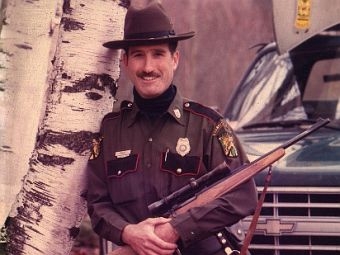In the continuing saga of Pete the Moose, only two questions seemed to remain Tuesday after the House approved a bill to return control of the caged cervid to the “public trust” and the Department of Fish and Wildlife.
Neither question had to do with whether the bill is likely to become law. It is. Even Rep. Robert Lewis, the Derby Republican who made the strongest argument against H. 91 when it cleared the Committee on Fish, Wildlife, and Water Resources last week, acknowledged that the Senate would probably pass the measure and send it to Gov. Peter Shumlin for his signature.
Lewis said he wouldn’t even bother to try to persuade senators to oppose the bill.
more
Mar 23, 2011 | The Associated Press ... MONTPELIER -- Pete the Moose has moved a big step toward having special protection under Vermont law. The moose, which lives on a game preserve in Irasburg, became a popular cause .. more
The following letter was sent to all House Members prior to the vote:
March 14, 2011
Vermont House of Representatives
Montpelier, VT 05602
Dear Member of the House,
The following groups support House Bill No. 91 entitled “An act relating to the management of fish and wildlife” as passed by the House Fish, Wildlife and Water Resource Committee. We urge passage of this important bill for the following reasons:
1. It clearly establishes wildlife as a public trust resource.
2. It confirms the Fish and Wildlife Department as the managers and trustees of the public’s wildlife.
3. It brings all wildlife back under the rule-making authority of the Fish and Wildlife Board.
4. It requires the relevant captive cervidae facility to be depopulated of native deer and moose and sets deadlines for compliance within a reasonable time frame.
The signature groups and leaders below represent thousands of Vermonters from all political views and parties, many who have helped to craft H.91 and have testified for its passage.
With regards,
Eric Nuse
Convener, Public Trust Coordinating Group
(802) 881-8502
Vermont Federation of Sportsmen’s Clubs
Hunters, Anglers & Trappers of Vermont (H.A.T.)
Hartford Rod & Gun Club
Barre Fish and Game Club
Vermont Natural Resources Council
Lamoille Valley Fish and Game Club
Vermont Bear Houndsmen
Fish & Wildlife Board
National Wildlife Federation
Orion-The Hunter’s Institute
Sportsmen Inc.
Wild in Vermont, Inc.
New Hampshire & Vermont Outdoor Gazette
Rob Boroski, past Chair of the F&W Board and Vt F&W Advisory Committee
Mountain Deer Taxidermy, Rodney and Theresa Elmer
Bradley Carleton, Champlain Valley Guide
Steve Wright, former Fish and Wildlife Dept. Commissioner
Vermont Trappers Association



